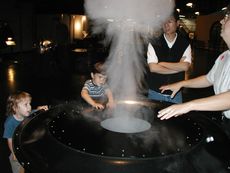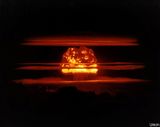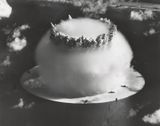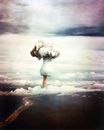سحابة عيش الغراب
(تم التحويل من Mushroom cloud)
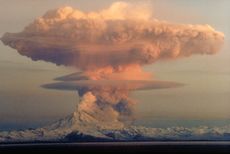
Ascending cloud from Redoubt Volcano from an eruption on April 21, 1990. The mushroom-shaped plume rose from avalanches of hot debris (pyroclastic flows) that cascaded down the north flank of the volcano.
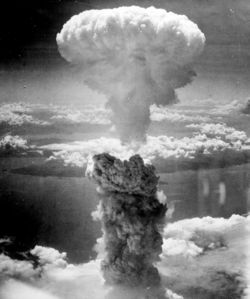
الانفجار الذرى في ناگاساكى باليابان في 19 أغسطس 1945.
سحابة الفطر أو سحابة عيش الغراب "Mushroom cloud" هي سحابة مميزة الشكل حيث تأخذ شكل فطر عيش الغراب "Mushroom"، وتتكون من دخان كثيف ولهب وحطام، الناتج عن انفجار هائل. وفى الغالب يتم الربط بين هذه السحابة والانفجارات النووية، لكن أيّ انفجار كبير بما فيه الكفاية سينتج نفس نوع التأثير. فالثورات البركانية والانفجارات الناتجة عن ارتطام الشهب والنيازك بسطح الأرض (Impact events) يمكنها ان تكون تلك السحابة.
أصل المصطلح
الفيزاء
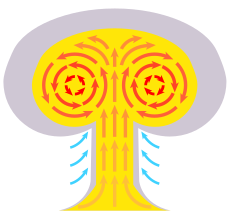
Inside a mushroom cloud: cooler air is drawn into the rising toroidal fireball, which itself cools into the familiar cloud appearance.
سحابات الفطر النووية
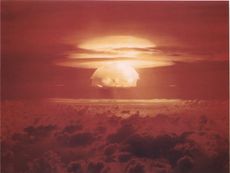
Castle Bravo, March 1, 1954 >15 Mt, showing multiple condensation rings and several ice caps.

Buster Charlie, 14 kt, initial phase of stem formation; toroidal fireball shown above, white condensation cloud forming due to intense updraft in the middle, forming stem below; red-brown hue of nitrogen oxides visible
تكوين السحابة
النظائر المشعة
توهج الفلورسنت
تأثيرات التكثيف
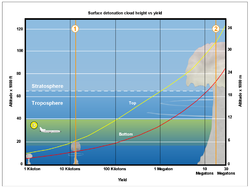
Mushroom cloud size as a function of yield.

The evolution of a nuclear mushroom cloud, from Upshot-Knothole Grable.
Mushroom cloud with prominent condensation ring from the Castle Romeo 11 Mt hydrogen bomb test
Mushroom cloud with multiple condensation rings from the Castle Union 6.9 Mt hydrogen bomb test
A 21-kiloton underwater nuclear weapon test, showing a Wilson cloud
Greenhouse George, 225 kt, showing a well-developed bell
الهامش
ببليوجرافيا
- Glasstone, Samuel, and Dolan, Philip J. The Effects of Nuclear Weapons 3rd edn. Washington, DC: United States Department of Defense and Energy Research and Development Administration, 1977. (esp. "Chronological development of an air-burst" and "Description of Air and Surface Bursts" in Chapter II)
- Vigh, Jonathan. Mechanisms by Which the Atmosphere Adjusts to an Extremely Large Explosive Event, 2001.

The mushroom cloud from Buster-Jangle Charlie, yield 14 kilotons (at 143 m • kt −1⁄3), during the initial phase of stem formation. The toroidal fireball is visible at the top, a condensation cloud is forming in the middle due to intense updrafts of moist air, and the forming partial stem can be seen below. The cloud exhibits the reddish-brown hue of nitrogen oxides.
المصادر
مصادر اخري
- Glasstone, Samuel, and Dolan, Philip J. The Effects of Nuclear Weapons[dead link] 3rd edn. Washington, D.C.: United States Department of Defense and Energy Research and Development Administration, 1977. (esp. "Chronological development of an air-burst" and "Description of Air and Surface Bursts" in Chapter II)
- Vigh, Jonathan. Mechanisms by Which the Atmosphere Adjusts to an Extremely Large Explosive Event, 2001.
وصلات خارجية
مشاع المعرفة فيه ميديا متعلقة بموضوع Mushroom cloud.
- Carey Sublette's Nuclear Weapon Archive has many photographs of mushroom clouds
- DOE Nevada Site Office has many photographs of nuclear tests conducted at the Nevada Test Site and elsewhere
- Burning bulbs is a set of photographs by Kevin Tieskoetter, showing fine mushroom cloud structures generated by burning lightbulb filaments in air
This article may include material from Wikimedia licensed under CC BY-SA 4.0. Please comply with the license terms.
